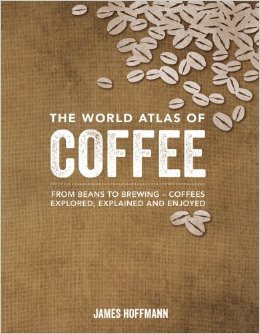 In 2014, James Hoffmann released a comprehensive informational book on the modern world of coffee. This beautiful hardcover book does a thorough job of cataloging all aspects of modern coffee varieties, growing methods, importing & trading concerns, roasting techniques, and coffee preparation methods. If you are interested to learn more about the fascinating world of coffee, The World Atlas of Coffee is a great place to start.
In 2014, James Hoffmann released a comprehensive informational book on the modern world of coffee. This beautiful hardcover book does a thorough job of cataloging all aspects of modern coffee varieties, growing methods, importing & trading concerns, roasting techniques, and coffee preparation methods. If you are interested to learn more about the fascinating world of coffee, The World Atlas of Coffee is a great place to start.
The book begins by introducing the reader to coffee itself including its anatomy, genetics, and varieties. It then moves into a detailed description of growing, harvesting, and processing techniques. From there, the reader is taken along the journey of trading and importing.
With these basics established, Hoffmann takes us into an overview of roasting, buying & storing, tasting, and preparation methods. The book does a great job of describing the differences between a Lungo, Macchiato, Ristretto, Cappuccino, and a Flat White, which can come in handy when visiting a growing number of Third Wave Coffee Cafes.
If you're in the market for a new espresso machine, The World Atlas of Coffee will not recommend a brand for you, but will educate you on the basic building blocks of these machines like the Heat-Exchanger, Dual-Boiler option, and Thermoblock construction.
The real heart of this book, though is in the Coffee Origins section. The origin of the coffee we drink can dictate so much about the social impact of our coffee buying decisions, the potential flavor of our coffee, and the overall quality of the final prepared cup. Roughly half of the book is dedicated to describing the various countries and regions in which coffee is grown. The regions cataloged cover three continents and 29 different countries. Each country is described in terms of:
- History of coffee within the given country
- Geographical growing regions within the country
- Grading methods
- Traceability and characteristics of the growing regions
- Taste profiles originating from the given country
- Varieties produced
For instance, when we read about Kenya, we learn that the AA grading represents beans that are the second largest bean grade (size 18 screen or 7.22mm). Kenya AA beans typically fetch the highest prices. We also learn that Kenya E grade beans (where E stands for elephant beans) are the largest sized beans that Kenya produces. Kenyan beans are known for their bright, complex berry/fruit qualities as well as their sweetness and intense acidity. Most people believe the first crop of coffee in Kenya was a bourbon variety harvested in 1896. Since that time, Kenya's crop and varietals have undergone significant development via research and improvements in farming methods. The most popular specialty coffees in Kenya today are SL-28 and SL-34, which are descendants of the Bourbon variety and came out of Scott Laboratories and French Mission Bourbon back in the 1930s.
As you enter the world of specialty coffee, this book can be an excellent high level guide to help you navigate the different varieties, origins, and production methods used in the industry.
The hardcover book is $26.60 on Amazon and is definitely worth the price. It will make a beautiful edition to any coffee table and offers some interesting reading that will surely enhance your morning cup.
For more on James Hoffmann, be sure to check out his AMA on Reddit and his blog post on this book.

